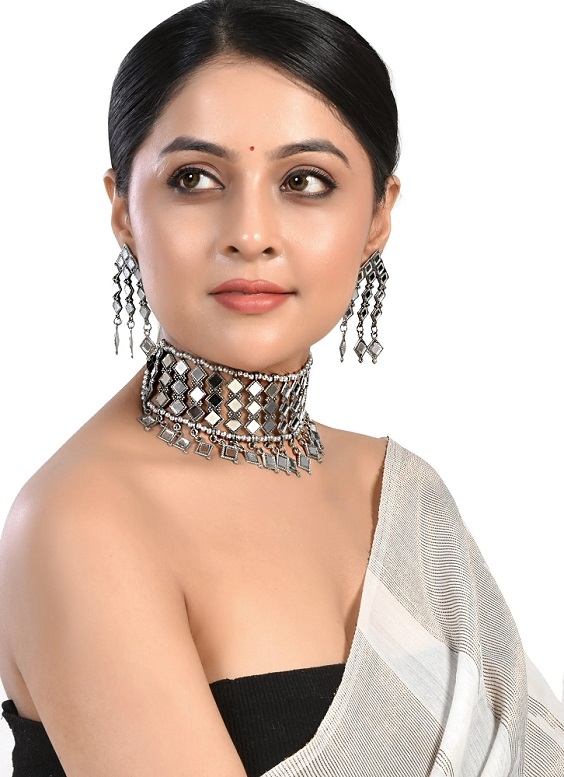Tribal traditions to trendy statements
| Date :17-Feb-2025 |

By Rupa Borekar :
FASHION is a constantly evolving landscape, influenced by
a wide array of cultural, social,
and historical elements. Among
the most notable shifts are the
incorporation of traditional tribal
practices into mainstream fashion. Practices such as wearing tattoos, sarees without blouses, and
adorning oneself with oxidised jewelry, once steeped in deep cultural significance, have found their
place in the world of fashion.Today,
these elements are not just symbols of heritage; they have become
statements of style, beauty, and
individuality. However, this transition from tradition to trend often
raises questions about cultural
appropriation and the loss of the
original meaning behind these
practices.
The tribal significance of
tattoos .

In many tribal cultures, tattoos
were more than just body art; they
were sacred symbols, used to
denote personal milestones, spiritual beliefs, or community status.
For example, in tribes like the Maori
in New Zealand, tattoos (or moko)
signified the wearer’s tribe, status,
and even individual achievements.
These tattoos were integral to identity and cultural pride, often tied
to rites of passage and marking
transitions in one’s life.
Today, tattoos have transcended their traditional roots and are
now a global fashion trend. While
they still hold personal significance
for many, the mainstream adoption of tattoos has turned them
into more of an aesthetic choice.
Celebrities and influencers often
flaunt tattoos as a form of selfexpression, sometimes without a
deeper connection to the original
meanings they held within tribal
communities. What was once a
sacred ritual is now celebrated for
its artistic expression and the way
it transforms the body into a canvas.

However, this shift has sparked
conversations about whether
the true essence of tribal
tattoos is being overlooked in favor of
trendy designs.
The saree without
a blouse
The saree, one of
India’s most iconic traditional garments, has
undergone various transformations over the years. While
the saree is typically worn with a
blouse, many tribal cultures have
long embraced the practice of
wearing sarees without one, often
for reasons of comfort and practicality. For women in rural or tribal regions, the blouse-less saree
became a way to dress that was in
line with both cultural tradition
and daily life. In recent years, however, the saree without a blouse has
taken on a new identity in the fashion world. Indian designers and
celebrities have embraced the
blouse-less style as a bold and liberating fashion statement. In the
fashion scene, it’s now considered
a chic, avant-garde look that challenges conventional norms. While
it celebrates body confidence and
freedom, the trend also invites a
conversation about cultural appropriation.What was once an expression of tribal culture has become
a fashionable way of showcasing
one’s body, often without acknowledging the deeper cultural roots of
the practice.
Oxidised jewelry: A symbol of
heritage
Oxidised jewelry, characterised by its darkened,
antique finish, has
long been a staple of
tribal and folk art. In
many communities,
these pieces were
more than just ornaments - they were
symbolic of community bonds, spiritual beliefs,
and even wealth or status.
Handcrafted by skilled artisans,
oxidised jewelry was often used in
important ceremonies and rituals,
passed down through generations
as heirlooms.
Today, oxidised jewelry has
become a sought-after fashion
trend, appreciated for its vintage
charm and versatility. Fashion
designers, both in India and globally, have embraced these intricate
pieces, often blending them into
contemporary outfits to create a
bohemian or vintage-inspired look.
While the jewelry’s aesthetic appeal
has made it a global fashion statement, it is important to remember
the rich cultural significance it once
held. The shift from tribal adornment to a fashion accessory has
sparked discussions about how
these items, once deeply connected
to community identity and traditions are now worn without understanding their original purpose.
As fashion continues to evolve,
we see a blend of traditional and
contemporary influences shaping
the trends of today. Elements like
tattoos, sarees without blouses,
and oxidised jewelry, once deeply
rooted in tribal culture, now stand
as markers of modern fashion.This
evolution reflects a broader trend
of cultural borrowing, where elements of tradition are reinterpreted to fit contemporary aesthetics.
However, the shift from cultural heritage to mainstream fashion
does come with complexities.
While these tribal traditions are
celebrated in today’s fashion, it is
essential to remember their deep
cultural significance.
The line
between cultural appreciation and
appropriation is thin, and it’s
important to engage with these
practices respectfully, acknowledging their roots even as they take
on new forms. The blending of tradition and trend offers an exciting
exploration of how culture and
fashion can coexist, but it also calls
for mindful consideration of the
history and meaning behind the
garments, accessories, and body
art we choose to wear.
